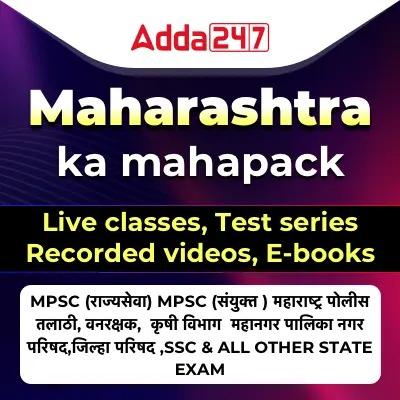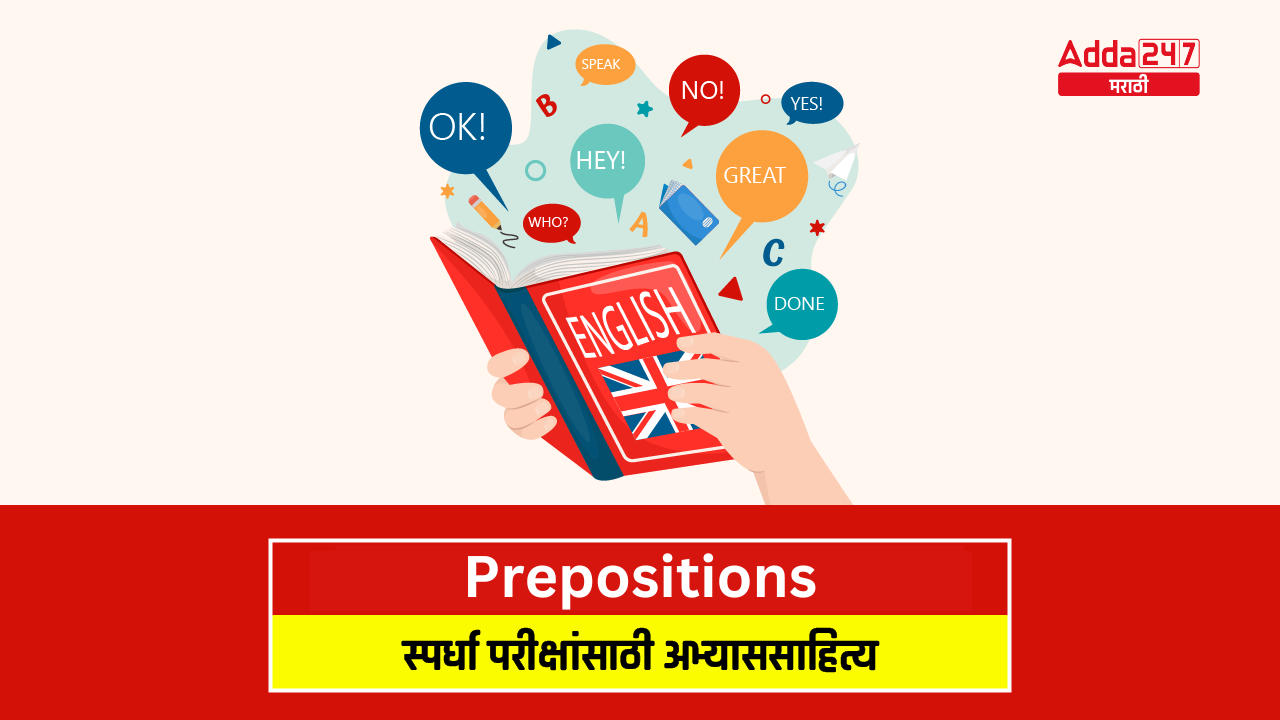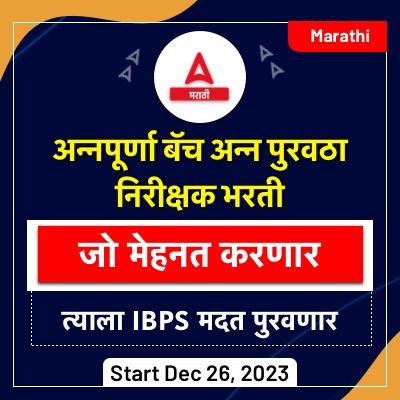Table of Contents
Preposition
Preposition: महाराष्ट्रातील तसेच राज्यातील बहुतेक स्पर्धा परीक्षेचा महत्वाचा विषय म्हणजे इंग्लिश. इंग्लिश विषयात जास्तकरून इंग्लिश ग्रामर वर प्रश्न विचारले जातात. नेहमीच्या सरावाने इंग्लिश विषयात चांगले गुण मिळू शकतात. आगामी काळातील सरळसेवा भरती जसे की, अन्न व नागरी पुरवठा विभाग भरती आणि इतर स्पर्धा परीक्षांमध्ये इंग्लिश ग्रामरला विशेष महत्त्व आहे. इंग्लिश ग्रामर चे रोज वाचन फायदेशीर ठरते. इंग्लिश ग्रामर मधील एक महत्वपूर्ण घटक म्हणजे Preposition. यावर परीक्षेत हमखास 1 ते 2 प्रश्न विचारले जाऊ शकतात. या लेखात आपण Preposition व त्यातील महत्वाचे नियम यावर माहिती पाहणार आहोत.
Preposition: विहंगावलोकन
इंग्रजी व्याकरणाचा अभ्यास करतांना Preposition या घटकाचा अभ्यास करणे महत्वाचे ठरते. या लेखात Prepositionबद्दल सविस्तर माहिती दिली आहे.
| Preposition: विहंगावलोकन | |
| श्रेणी | अभ्यास साहित्य |
| उपयोगिता | अन्न व नागरी पुरवठा विभाग आणि इतर सर्व स्पर्धा परीक्षांसाठी उपयुक्त |
| विषय | इंग्रजी व्याकरण |
| लेखाचे नाव | Preposition |
| लेखातील प्रमुख मुद्दे |
|
What is a Preposition? | प्रीपोझिशन म्हणजे काय?
A preposition is part of speech in English grammar that is a word or set of words that indicate the location or some other relationship between a noun or pronoun and also other parts of a sentence. A preposition shows the relationship between a word in the sentence and the word that is the object of the preposition. Preposition is known as “the biggest little words” in English because of its important functions.
प्रीपोझिशन हा इंग्रजी व्याकरणातील भाषणाचा भाग आहे जो एक शब्द किंवा शब्दांचा संच आहे जो संज्ञा किंवा सर्वनाम आणि वाक्याच्या इतर भागांमधील स्थान किंवा काही अन्य संबंध दर्शवितो. प्रीपोझिशन वाक्यातील शब्द आणि प्रीपोझिशनचा ऑब्जेक्ट असलेला शब्द यांच्यातील संबंध दर्शवते. प्रीपोझिशनला त्याच्या महत्त्वाच्या कार्यांमुळे इंग्रजीमध्ये “सर्वात मोठे छोटे शब्द” असे म्हणतात.
Types of Prepositions
Prepositions are words that show the relationship between nouns or pronouns and other words in a sentence. Some common types of prepositions include:
1. Time prepositions: These show the relationship between nouns or pronouns and time. Examples include “at,” “on,” “in,” “before,” “after,” “during,” and “since.”
2. Place prepositions: These show the relationship between nouns or pronouns and location. Examples include “in,” “on,” “at,” “under,” “over,” “beside,” “behind,” and “between.”
3. Directional prepositions: These show the relationship between nouns or pronouns and direction. Examples include “to,” “from,” “toward,” “into,” “onto,” and “out of.”
4. Manner prepositions: These show the relationship between nouns or pronouns and manner or method. Examples include “with,” “by,” “like,” “as,” and “through.”
5. Agentive prepositions: These show the relationship between nouns or pronouns and an agent or cause. Examples include “by,” “through,” and “because of.”
6. Instrumental prepositions: These show the relationship between nouns or pronouns and instruments or tools. Examples include “with,” “by,” and “using.”
7. Possessive prepositions: These show the relationship between nouns or pronouns and possession. Examples include “of,” “for,” and “belonging to.”
Rules of Preposition
Rule 1 A preposition cannot be followed by a verb. Verb placed immediately after preposition must be in gerund form.
Examples (a) He prevented me from drinking hot water.
(b) He insists on trying once again.
Rule 2 When ‘object’ of the preposition is an Interrogative Pronoun What, Who, Whom, Which, Where etc., the preposition usually takes end or front position.
Examples (a) May I know who were you talking to?
(b) What are you thinking of?
It used to be thought as ungrammatical, to end a sentence with a preposition, but it is now well accepted.
Rule 3 When ‘object’ of the preposition is a relative Pronoun ‘that’, the preposition takes end position.
Examples (a) Here is the magazine that you asked for.
(b) This is the dish that she is fond of.
Rule 4 When the ‘object’ of the preposition is infinitive (to + verb), preposition is placed after infinitive.
Examples (a) This is a good hotel to stay at.
(b) I need a pencil to write with.
Rule 5. In some sentences, preposition is attached with the verb.
Examples (a) I hate being laughed at.
(b) This I insist on.
Rule 6. In interrogative sentences preposition comes in the beginning.
Examples (a) By which train did you come?
(b) For whom was instructions given?
Use and examples of Some Important Prepositions
At/In/On
In reference of ‘Time’
- At is used for a precise time.
- In is used for months, years, centuries and long periods.
- On is used for days and dates.
In reference of ‘Place’
- At is used for a point.
- In is used for an enclosed space.
- On is used for a surface.
(A) At shows stationary position or existing state while In shows movement.
Examples i. She is at home.
ii. The train is in motion.
(B) At for small place, town etc. while In for big place, town, city, country etc.
Examples i. He lives at Alwar in Rajasthan.
ii. A temple is situated at Madurai in Chennai.
(C) At is used for Point of time, and In is used for Period of time.
Examples i. The train will arrive at six in the morning.
ii. He will meet you in the morning.
(D) In/Into In shows the existing state of things, while Into shows movement.
Examples i. He jumped into the river.
ii. There are three students in the class.
To/Into/To
- In the direction of Turn to the right.
- Destination I am going to Jaipur.
- Until From Monday to Friday; five minutes to ten
- Compared with They prefer hockey to soccer.
- With indirect object Please give it to me.
- As part of infinitive I like to ski; he wants to help.
- In order to We went to the store to buy soap.
- To the inside of We stepped into the room.
- Change of condition The boy changed into a man.
On/Onto
On can be used for both existing position and movement.
Example (a) He was sitting on his bag.
(b) Snow fell on the hills.
On can also be used as an adverb
Examples (a) Go on.
(b) Come on.
Onto is used when there is movement involving a change of level.
Examples (a) People climbed onto their roofs.
(b) He lifted her onto the table.
With/By With is used for instruments, and By is used for agents.
Examples (a) The snake was killed by him with a stick.
(b) The letter was written by Suresh with a pencil.
Since/For/From Since is often used with Present Perfect or Past Perfect Tense
Examples (a) It has been raining since two O’ Clock.
(b) He had been ill since Monday.
Since can also be used as an adverb
Examples (a) He left school in 1983. I haven’t seen him since.
(b) It is two years since I last saw Tom.
Beside/Besides Beside and Besides have altogether different meanings.
Don’t confuse beside with besides. beside = at the side of
Example: a)He was sitting beside Sarla.
b) besides = in addition to / as well as
Between/Among
Between is normally used for ‘two things or persons, but it can also be used more, when we have a definite number in mind and there is a close relationship/ association within them.
Example –He distributed his property between his two daughters.
Among is usually used for more than two persons or things when we have no definite number in mind.
Example –He was happy to be among friends again.
Among/Amongst
Both have the same meaning. Either of them can be used if followed by ‘the’. If followed by a word, beginning with a vowel ‘amongst’ be used.
Examples
He distributed the toffees among/amongst the poor.
He distributed the toffies amongst us.
Preposition: नमुना प्रश्न
Direction (1 – 5): Choose the correct preposition in each sentence.
1. If she left at 4 p.m., she should be here_______ now.
2. Go ____________there and catch my ball.
3. ___________ your determination, you will be able to achieve your dream.
4. I just found it! It was_______ the radio on my desk.
5. I knocked________ him accidentally
Solutions
1. by; With context to time, preposition ‘by’ means ‘not later than’ or ‘at or before a particular time’. Hence, as per the sense of the sentence, ‘by’ should be used here.
2. over; Preposition ‘over’ means ‘ across from one side to the other’. Hence ‘over’ should be used here.
3. With; Preposition ‘with’ means ‘accompanied by’. Hence, ‘with’ should be used here.
4. by; With context to position, ‘by ‘ means ‘at the side of’. Hence ‘by’ should be used here.
5. over; ‘knock someone over’ means ‘to strike or collide with someone so as to cause them to fall to the ground.
महाराष्ट्रातील सर्व स्पर्धा परीक्षांसाठी ऑनलाईन क्लास, व्हिडिओ कोर्स, टेस्ट सिरीज, पुस्तके आणि इतर अभ्यास साहित्य खाली दिलेल्या लिंक वर क्लिक करून मिळावा.
अड्डा 247 मराठी अँप | अड्डा 247 मराठी टेलिग्राम ग्रुप









